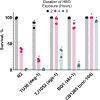Oxygen is toxic in the cold in C. elegans
- PMID: 39777359
- PMCID: PMC11703811
- DOI: 10.3389/fphys.2024.1471249
Oxygen is toxic in the cold in C. elegans
Abstract
Introduction: Temperature and oxygen are two factors that profoundly affect survival limits of animals; too much or too little of either is lethal. However, humans and other animals can exhibit exceptional survival when oxygen and temperature are simultaneously low. This research investigates the role of oxygen in the cold shock death of Caenorhabditis elegans.
Methods: The survival of C. elegans populations in combinations of oxygen concentrations and was assayed. Additionally, the effect of cold acclimatization, mutations in the cold acclimatization pathway, compounds, and antioxidant proteins on survival in low temperatures and high oxygen were investigated.
Results: We demonstrate that C. elegans have increased survival in 2°C when deprived of oxygen, and an increase to just 0.25 kPa of oxygen decreased survival. Additionally, we show that oxygen toxicity produced by a 35-fold increase above atmospheric oxygen levels was fatal for nematodes in 8 h at room temperature and 2 h at 2°C. We found that cold acclimatization and mutations in the cold acclimatization pathway improve survival in room temperature oxygen toxicity. Furthermore, we found that the compounds glucose, manganese (II), and ascorbate improve both cold shock and high oxygen survival, while the antioxidant proteins catalase and peroxiredoxin are essential to wild type survival in these conditions.
Discussion: Our results suggest that oxygen toxicity contributes to the death of C. elegans during cold shock. The changes in survival induced by cold acclimatization and mutations in the cold acclimatization pathway suggest that oxygen toxicity in the cold exerts evolutionary pressure, leading to the development of protections against it. Additionally, the resistance provided by diverse compounds and antioxidant proteins in both low temperature and high oxygen suggests these conditions have similar chemical environments. We discuss evidence that similar phenomena may function in humans.
Keywords: C. elegans; ROS; cold acclimatization; cold shock; oxidative stress; oxygen; survival; temperature.
Copyright © 2024 Suraci, Morrison and Roth.
Conflict of interest statement
The authors declare that the research was conducted in the absence of any commercial or financial relationships that could be construed as a potential conflict of interest.
Figures


 , 4
, 4  , 8
, 8  . *P < 0.05 when comparing to 377 kPa. See ST4.
. *P < 0.05 when comparing to 377 kPa. See ST4.

 , 4
, 4  , 8
, 8  , 12
, 12  . *P < 0.05 when comparing to animals grown at 23°C. See ST7.
. *P < 0.05 when comparing to animals grown at 23°C. See ST7.
 , 4
, 4  , 8
, 8  . *P < 0.05 when comparing to wild type (N2). See ST8.
. *P < 0.05 when comparing to wild type (N2). See ST8.
 , 6
, 6  , 12
, 12  . See ST9. (B) Survival in HBO, duration in hours 2
. See ST9. (B) Survival in HBO, duration in hours 2  , 4
, 4  , 8
, 8  . *P < 0.05 when comparing to control (untreated) animals. See ST10.
. *P < 0.05 when comparing to control (untreated) animals. See ST10.
 , 6
, 6  , 12
, 12  . See ST11. (B) Survival in HBO, duration in hours 2
. See ST11. (B) Survival in HBO, duration in hours 2  , 4
, 4  , 8
, 8  . *P < 0.05 when comparing to control (untreated) animals. See ST12.
. *P < 0.05 when comparing to control (untreated) animals. See ST12.References
LinkOut - more resources
Full Text Sources

